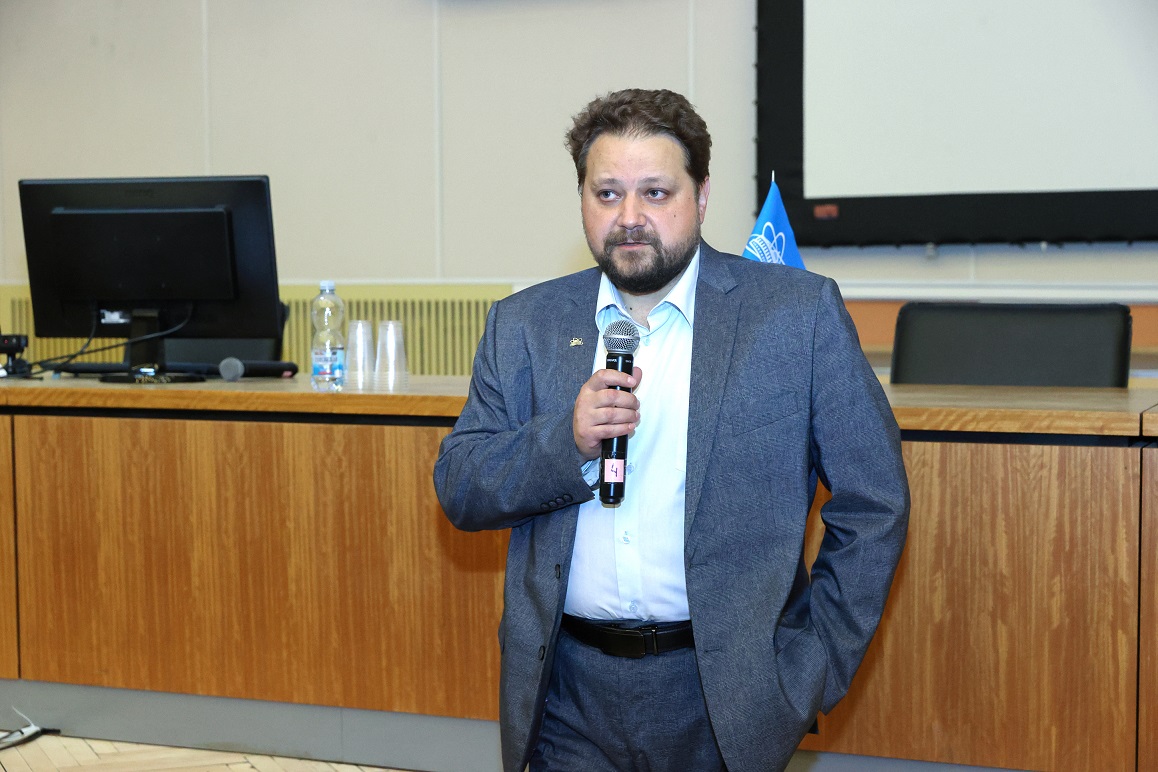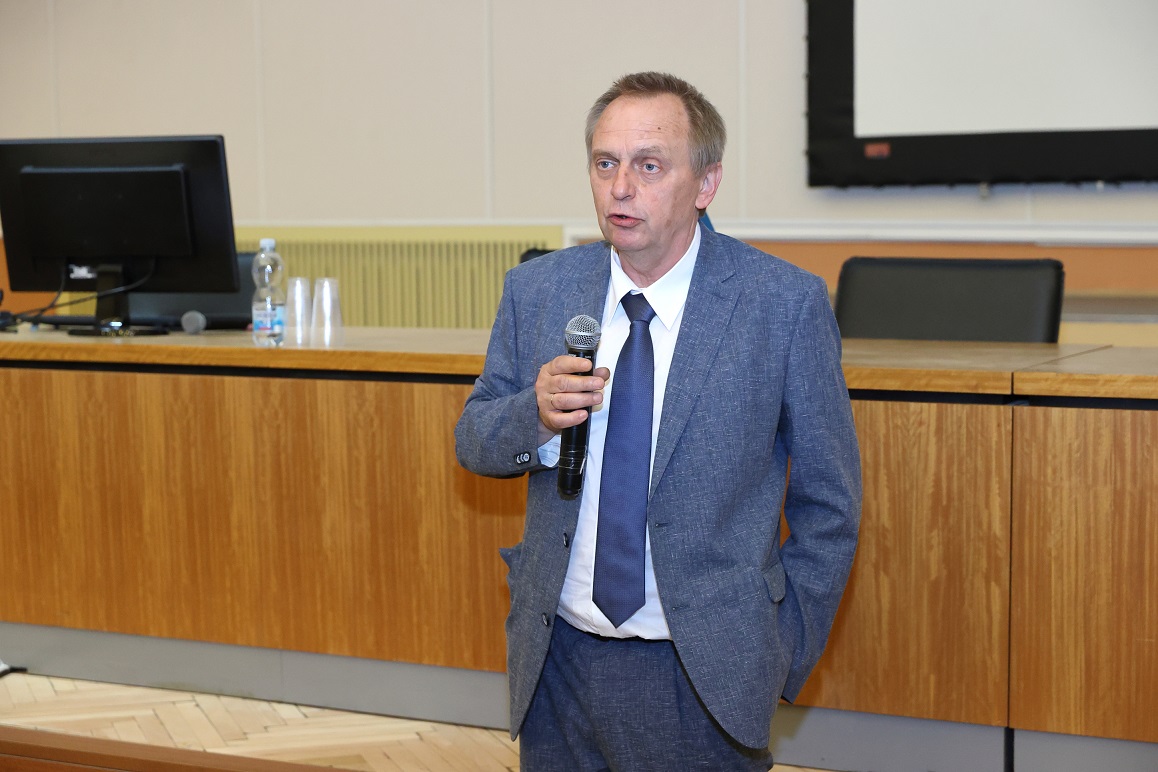‘Two Interdisciplinary Research Centres Can Create New Synergy between Themselves’
.jpg)
In mid-June 2024, HSE University and the Joint Institute for Nuclear Research in Dubna held a joint working meeting. This meeting was the first under an agreement signed by the research centres in 2024, when HSE University and JINR agreed to jointly participate in experiments of the NICA megascience project, as well as interact in the field of theoretical and mathematical physics, information technology, and personnel training. These issues were the focus of the first working meeting. Details are in the JINR report.
The plenary session was opened by Acting Director of JINR’s Laboratory of High Energy Physics Andrey Butenko. He spoke on the status of the NICA megascience project.

‘We’ve set the bar at the highest level for the country and the world, and we are easily competing with the world’s leading centres in our field. We must continue to work in the same direction and attract new scientists, such as mathematicians and physicists. We are pleased to expand our cooperation with you. Today, we are launching the collider; in a year, the first data will be available, and everything will grow like an avalanche. Your participation in the project is necessary not only for you, but for us as well,’ Andrey Butenko addressed his colleagues from HSE University.

Chief Scientific Secretary of JINR Sergey Nedelko introduced the Joint Institute, emphasising that, in terms of the scale, range, and effectiveness of research, as well as the number of employees, it is one of the leaders among international intergovernmental scientific organisations. Sergey Nedelko also noted that, due to the multidisciplinary nature and peculiarities of their work organisation, JINR and HSE University have a high potential for expanding their cooperation.

HSE University’s Senior Director for Research and Development Alexey Sudarikov presented the structure and activities of HSE University, which is a large scientific and educational complex. ‘Two interdisciplinary scientific centres can create new synergy among themselves. They can interact and find partners who are mutually interested in working together,’ said Alexey Sudarikov.
The meeting featured several parallel sections dedicated to cooperation between HSE University and JINR. The scientific programme of the MPD, SPD, and BM@N NICA experimental collaborations was discussed in detail.
'JINR and HSE University have been working together for a long time on the MPD, BM@N and SPD experiments of the NICA project. The HSE University research group, one of Russia’s strongest in this field, is engaged in machine learning and its application in particle physics. During the section, the results of existing cooperation were summed up and directions for further development were outlined,’ noted Deputy Chief Scientific Secretary of JINR Alexey Zhemchugov.
The researchers also focused on mathematical methods in life sciences, aspects of modern mathematics and mathematical physics, as well as the development of information technologies for storing and processing data from physical experiments. They addressed the challenges of training highly qualified scientific personnel, including the possibility of conducting student internships at JINR.
See also:
Physicists Propose New Mechanism to Enhance Superconductivity with 'Quantum Glue'
A team of researchers, including scientists from HSE MIEM, has demonstrated that defects in a material can enhance, rather than hinder, superconductivity. This occurs through interaction between defective and cleaner regions, which creates a 'quantum glue'—a uniform component that binds distinct superconducting regions into a single network. Calculations confirm that this mechanism could aid in developing superconductors that operate at higher temperatures. The study has been published in Communications Physics.
'Even among Geniuses, Luck Plays a Role in Winning a Nobel Prize'
Denis Bodrov studies particle physics and works at one of the four electron–positron colliders in the world. In this interview with the HSE Young Scientists project, he talks about his efforts to go beyond the Standard Model, discusses tau leptons, and shares his affection for Moscow.
Physicists at HSE University Reveal How Vortices Behave in Two-Dimensional Turbulence
Researchers from the Landau Institute for Theoretical Physics of the Russian Academy of Sciences and the HSE University's Faculty of Physics have discovered how external forces affect the behaviour of turbulent flows. The scientists showed that even a small external torque can stabilise the system and extend the lifetime of large vortices. These findings may improve the accuracy of models of atmospheric and oceanic circulation. The paper has been published in Physics of Fluids.
New Method for Describing Graphene Simplifies Analysis of Nanomaterials
An international team, including scientists from HSE University, has proposed a new mathematical method to analyse the structure of graphene. The scientists demonstrated that the characteristics of a graphene lattice can be represented using a three-step random walk model of a particle. This approach allows the lattice to be described more quickly and without cumbersome calculations. The study has been published in Journal of Physics A: Mathematical and Theoretical.
‘It Was Interesting to See How Our Chinese Colleagues Work’: HSE Researchers Take Part in Hefei Summer School
This summer, Diana Sukhoverkhova, Daria Mazur, and David Kagramanyan, research assistants at the MIEM HSE Laboratory for Computational Physics, spent five weeks in China. At the Future Scientist Exchange Program (FuSEP) summer school in Hefei, they worked in new fields of science together with their Chinese colleagues. HSE's promising scientists spoke to the HSE News Service about their intense and productive time in China.
‘The Fundamental Principle of Scientific Knowledge Is Honesty’
Daria Mazur has wanted to pursue science since she was 13 years old—ever since she discovered in the seventh grade that she was good at physics. In an interview for the HSE Young Scientists project, she spoke about her theoretical research on the electric double layer, speed reading, and the MGMT song ‘Little Dark Age.’
Russian Scientists Reconstruct Dynamics of Brain Neuron Model Using Neural Network
Researchers from HSE University in Nizhny Novgorod have shown that a neural network can reconstruct the dynamics of a brain neuron model using just a single set of measurements, such as recordings of its electrical activity. The developed neural network was trained to reconstruct the system's full dynamics and predict its behaviour under changing conditions. This method enables the investigation of complex biological processes, even when not all necessary measurements are available. The study has been published in Chaos, Solitons & Fractals.
Russian Physicists Discover Method to Increase Number of Atoms in Quantum Sensors
Physicists from the Institute of Spectroscopy of the Russian Academy of Sciences and HSE University have successfully trapped rubidium-87 atoms for over four seconds. Their method can help improve the accuracy of quantum sensors, where both the number of trapped atoms and the trapping time are crucial. Such quantum systems are used to study dark matter, refine navigation systems, and aid in mineral exploration. The study findings have been published in the Journal of Experimental and Theoretical Physics Letters.
Russian Scientists Demonstrate How Disorder Contributes to Emergence of Unusual Superconductivity
Researchers at HSE University and MIPT have investigated how the composition of electrons in a superconductor influences the emergence of intertype superconductivity—a unique state in which superconductors display unusual properties. It was previously believed that intertype superconductivity occurs only in materials with minimal impurities. However, the scientists discovered that the region of intertype superconductivity not only persists but can also expand in materials with a high concentration of impurities and defects. In the future, these superconductors could contribute to the development of highly sensitive sensors and detectors. The study has been published in Frontiers of Physics.
Scientists at HSE University Devise More Accurate Method for Predicting the Electrical Conductivity of Electrolyte Solutions
Researchers at HSE MIEM have developed a model for calculating the electrical conductivity of aqueous electrolyte solutions; for the first time, it considers the spatial distribution of ion charges instead of assuming their localisation at a single point. The model remains effective even at high electrolyte concentrations and across a wide temperature range. This breakthrough will contribute to the development of more efficient batteries and enable the calculation of electrical conductivity without the need for experimental testing. The study has been published in the Journal of Chemical Physics.


